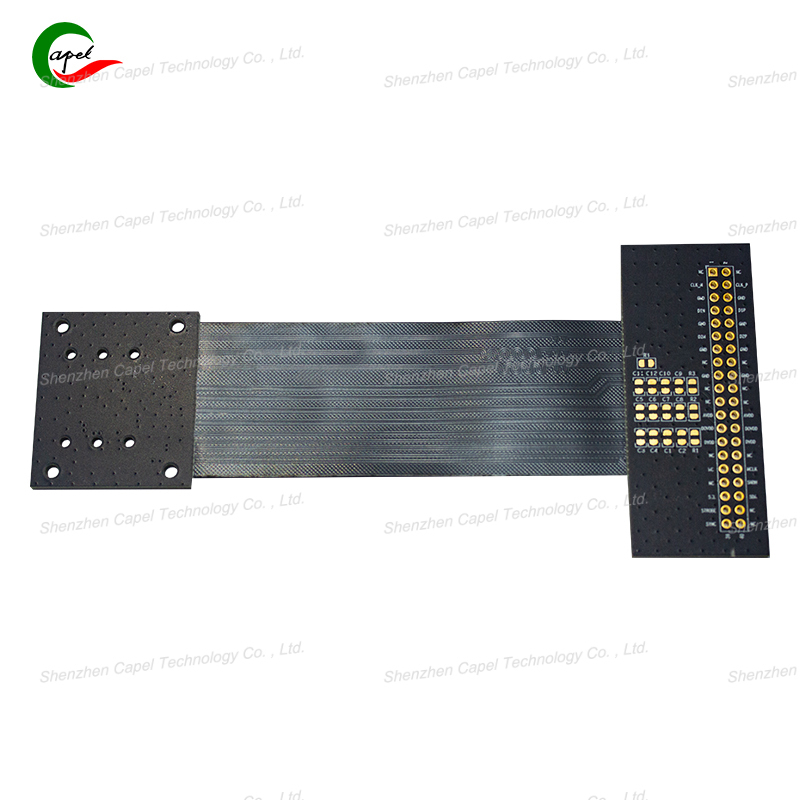Date: 2025-10-20
Let's be honest – if you're designing high-frequency flexible PCBs that need to bend, you've probably seen those subtle signal integrity issues that appear after a few hundred flex cycles. The problem isn't your initial impedance calculation; it's what happens when your carefully designed 50Ω trace gets stretched, compressed, and distorted during actual use.
Unlike rigid boards, flex circuits change physically during operation – and that means their electrical characteristics change too. I've seen 5G modules in foldable devices fail because impedance drifted 15% beyond tolerance after just 500 bending cycles. The solution isn't real-time tuning (too complex for most applications) but building compensation directly into your design from day one.
Before we fix the problem, we need to understand what's actually happening to your traces:
The Dielectric Constant Isn't Constant - When you bend polyimide, you're literally stretching its molecular structure. This changes the Dk by 5-15% – enough to shift your impedance significantly. I've measured Dk variations from 3.2 to 4.4 on the same material during different bending scenarios.
Traces Get Cozy - At tight bend radii (1x board thickness), adjacent traces can move 20% closer together due to substrate deformation. For differential pairs with 0.3mm spacing, this alone can drop impedance by 8-12%.
Your Traces Aren't Rectangle Anymore - Bending transforms your perfect rectangular traces into elliptical shapes. This increases effective width and reduces impedance – especially problematic at bend radii ≤1x board thickness.
Without addressing these issues upfront, you're guaranteed to exceed ±10% impedance drift – far beyond the ±5% tolerance that high-speed signals demand.
Here's how we build impedance stability into our flex designs:
1. Start with the Right Materials
The foundation of stable impedance is using materials that behave predictably under stress:
Go with High-Purity PI - Not all polyimide is created equal. We specify grades like DuPont Kapton® HN that show ≤±2% Dk variation during bending, compared to ±5% for generic alternatives. The extra cost is trivial compared to the yield loss from impedance issues.
Consider Fluoropolymer Coatings - Adding a thin 10μm fluoropolymer coating can reduce Dk drift by 30% by stabilizing the substrate during bending.
Match Your Copper CTE - Using 18-25μm copper foil with CTE matching the PI (around 50 ppm/°C) minimizes the mechanical mismatch that distorts trace geometry.
Choose Flexible Solder Mask - Rigid epoxy solder masks create stress points. UV-curable polyimide solder mask (15-20μm) flexes with your board instead of fighting it.

2. Design Traces That Compensate for Themselves
This is where the real engineering happens:
The 5-8% Overdesign Rule - For a target 50Ω impedance, we design our static impedance to 52.5-54Ω. The natural impedance reduction during bending then brings it right into our target range. This simple trick has solved more impedance problems than any other single technique.
Switch to Trapezoidal Traces - This is counterintuitive but incredibly effective. Traces with top width 0.8x bottom width show 40% less impedance variation during bending compared to rectangular traces. The trapezoidal shape maintains more consistent effective width as the board flexes.
Add Spacing Margin - Increase trace spacing by 10-15% over your static calculation. This provides crucial buffer space for the natural spacing shrinkage that occurs during bending.
3. Work Smarter with Your Stackup and Layout
Structural decisions can make or break your impedance stability:
Graduate Those Transitions - Sharp 90° rigid-flex transitions are impedance disaster zones. Implementing 0.5-1.0mm radius curves spreads bending stress evenly and dramatically reduces Dk variation.
Route on the Neutral Axis - In multi-layer flex designs, always route high-frequency traces along the neutral axis (the middle layer). This area experiences minimal stretching or compression during bending – we've measured 50% reduction in impedance drift using this approach alone.
Reinforce Strategically - Adding 25-50μm PI reinforcement near (but not covering) trace bends stabilizes the substrate without making the area too stiff.
4. When to Bring in Passive Components
For applications above 5GHz (like 5G mmWave), sometimes you need extra help:
Micro Capacitors for Fine-Tuning - Place 0402-sized chip capacitors (1-10pF) parallel to trace segments prone to impedance increases. They counteract the inductive effects of stretched traces.
Thin-Film Resistors for Balance - 0603-sized resistors (50Ω) in series with long traces can stabilize impedance against geometry changes.
Critical: Keep components small (≤0402) and place them ≥1mm from actual bend zones. Larger components will crack; placing them too close to bends creates stress points.
Assuming All PI is Equal - Using generic polyimide with ±5%+ Dk variation guarantees your impedance will drift beyond acceptable limits, no matter how clever your trace design.
The Overcompensation Trap - Designing static impedance 10%+ above target might seem safe, but it leads to impedance that's too high after bending, causing signal reflection issues.
Using Rigid Components - Through-hole parts have no place on dynamic flex circuits. They will detach during bending and create immediate impedance spikes.
Trace Crowding - Packing high-frequency traces too close leaves no room for the natural spacing shrinkage during bending.
Don't wait for field failures to discover your compensation doesn't work:
Bending Cycle Test - Bend your PCB 1,000 times at operational radius while monitoring impedance with a VNA at 1GHz/5GHz. Drift should stay ≤±5%.
Dk Variation Check - Measure Dk before and after bending with a dielectric spectrometer. Variation ≤±2% indicates your material and structural approaches are working.
Signal Integrity Verification - Transmit a 5GHz signal through the bent PCB and check eye diagrams. A clean eye pattern doesn't lie – it's the ultimate proof of impedance stability.
Stable impedance in bending flex circuits comes down to: high-stability materials, intelligent trace design that anticipates change, strategic structural layout, and minimal passive compensation when absolutely necessary.
By building these principles into your design process, you can keep impedance drift within ±5% – making your high-frequency flexible designs actually work in the real world where bending happens.
related link:
Kaboer manufacturing PCBs since 2009. Professional technology and high-precision Printed Circuit Boards involved in Medical, IOT, UAV, Aviation, Automotive, Aerospace, Industrial Control, Artificial Intelligence, Consumer Electronics etc..